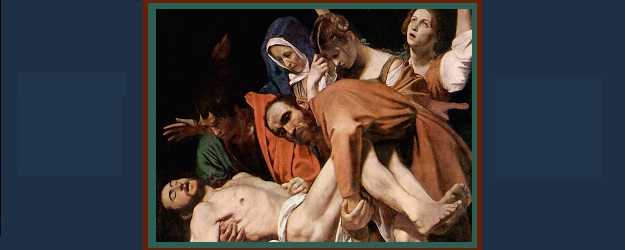
Burial of Christ, by Michelangelo Caravaggio, 1602-1604.
The Shroud of Turin was on public display from April 19, 2015 through June 24, 2015 in the Cathedral of St John the Baptist in Turin, Italy. More than two million visitors came to Turin from around the world to view the Shroud. “Some say the 14-foot piece of linen is Christ’s burial cloth. They point to what appears to be the imprinted image of a man bearing wounds from a crucifixion. Others say the whole thing is a medieval forgery. Regardless, the shroud has remained a wildly popular attraction for pilgrims from around the world.”1 The Shroud is certainly one of the most controversial relics in recent times. It has been displayed several times in this century, the last time in 2005.
I was one of those fortunate visitors to view the Shroud. The viewing was part of a pilgrimage my wife and I made to Italy in May 2015.
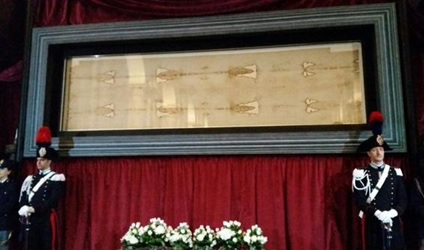
Figure 1: Shroud of Turin on Display
(https://shroudofturin.files.wordpress.com/2015/04/clip_image0013.jpg)
Introducing the Shroud
The cloth itself measures 14.3 x 3.7 feet. This is a rather strange size for the cloth unless one takes into account a length measurement of the time—the Assyrian cubit. Doing this the size of the cloth is 8 cubits by 2 cubits—a much more regular measurement. The cloth is woven in a three-to-one herringbone twill composed of flax fibrils. There appears a faint image of the front and back image of a naked man with his hands crossed over his groin. The front and back views meet nearly at the middle of the cloth with no outline of the figure. The two views are aligned along the mid-plane of the body and point in opposite directions and nearly meet in the middle. The image is so faint that it can only be seen from about 2–9 feet away. When viewed any closer, it tends to disappear, and any further away, it becomes rather indistinct.

Figure 2: Shroud as it appears to the unaided eye.
(Front of the body to the left, dorsal side of the body to the right.)
©1978 Barrie M. Schwortz Collection, STERA, Inc.
The image is of a man who was severely beaten and tortured. There are numerous blood stains on the cloth: on the wrists, feet, and head. The dorsal image shows what look like dumbbell-shaped images that are indicative of a whipping. There is a blood stain on the side of the victim that indicates a puncture wound of some sort. It would certainly have fit into a description of what we know of as a Roman crucifixion. There is an additional feature that is not known to be a part of a crucifixion—the cap (or “crown”) of thorns. We know of only one case where a cap of thorns is described, specifically in the Gospels about the crucifixion of Jesus Christ.
There are a number of triangular patches sown into the Shroud that were meant to repair damage done during a fire that occurred in 1532. Water stains also appear on the Shroud. The water stains on the centerline were presumably left from the water used to put out the fire, while the edge water stains may have occurred as a result of the method of storage in a large container.
The wounds indicate a traumatic experience for the individual. It must have been excruciatingly painful to undergo the experience suggested by the wounds on the Shroud. Several forensic experts have examined the Shroud. Each has decided that the evidence displayed is, indeed, realistic, and exactly as one would expect for the victim of a crucifixion.
Forensic experts have theorized about the exact cause of death. Dr. Pierre Barbet2 has speculated that asphyxiation was the cause of death. But Dr. Fredrick Zugibe3 considers the cause of death of the victim to be cardiac and respiratory arrest due to hypovolemic and traumatic shock from crucifixion. Both agree that the victim did indeed die on the cross.
Known History of the Shroud
The beginning of the well-documented history of what we today call the “Shroud of Turin” occurred in the 14th Century. It was in the possession of Geoffrey de Charny in the small town of Lirey, France. The Shroud of Turin has a known chain of custody from then to the present. Geoffrey de Charny was a French knight in the service of King John II of France. He was sufficiently well thought of to be entrusted with the French Oriflamme (the French battle standard) during battle.
There were questions raised at the time about its authenticity. In 1389, Bishop Pierre d’Arcis claimed, in a letter to the Anti-Pope Clement VII, that a painter had confessed to creating the Shroud. Pierre claimed that his predecessor, Bishop Henri de Poitiers of Troyes, conducted an inquest in which an un-named artist confessed to the painting. There is no evidence of such an inquest in documents of the time. Pierre stated that Henri had the Shroud removed from the church because it was a fake, yet other documents dispute this. Pierre’s claim indicated that the inquest caused the cloth to be hidden for “35 years or so.” (We can date the Shroud to 1354 from this claim.) Pierre’s memo is not dated or signed, both required for any official correspondence. The best that could be said of this document is that d’Arcis meant to send it, but had only written a rough draft. It is unlikely that the memo was ever sent to “Anti-Pope” Clement VII because no properly signed or sealed copies of it can be found in the Vatican or Avignon archives. No document of Anti-Pope Clement VII refers to it, suggesting it was never received.
Bishop Poitiers wrote to Geoffrey to praise him for his piety. Anti-Pope Clement VII told D’Arcis to be quiet, perpetually, about the Shroud, requiring Geoffrey to only claim it to be a figure or representation. No artist or inquest is mentioned in his letter.
There is, however, a possible explanation for the memorandum—if it actually existed. Pilgrims were a source of revenue, and people were flocking to Lirey to see the Shroud, as well as making donations to the Church. The cathedral at Troyes was unfinished; the nave had collapsed and needed repair. Bishop d’Arcis was very interested in putting his cathedral in order through the common practice of donations.
The Shroud stayed in Lirey until 1418. Geoffrey de Charny had died in 1398, and left his land to his daughter, Marguerite. Since Marguerite had no children—thus no direct heirs—she saw to it that the Shroud would be kept in safe hands by transferring the ownership of the Shroud to the House of Savoy before her death in 1460.
The Shroud traveled extensively with the House of Savoy for two decades before it was permanently moved to Turin by Duke Emmanuel-Philibert where it has been ever since. In 1983, the Shroud passed into the possession of the Pope when its then-owner, ex-King Umberto II of Italy, died. He bequeathed the Shroud to Pope John Paul II and his successors with the proviso that it stay in Turin. The Shroud is not then the property of the Catholic Church—it is the property of the Pope and his successors. The Turinese authorities are the custodians of the Shroud.
The history of the Shroud prior to this time is rather speculative. But there are clues, in both art work and in stories, that suggest that the Shroud was used as a model by artists throughout history for their own “icons” and other paintings. A number of these icons of Christ have very similar characteristics about them that are seen on the Shroud suggesting that the Shroud became their model for Christ. There are also coins that have images reminiscent of what we see on the Shroud. None of this is conclusive, however, but it is possible that the same model was available to all.
Scientific Study of the Shroud
The scientific study of the Shroud began in 1898 when Secondo Pia took the first photographs of the Shroud. His photographs were made during an exposition of the Shroud celebrating the 50th anniversary of the signing of the Italian constitution. Pia had been asked by the king himself to take the photos.
When Pia developed the photos, he expected to see a photographic negative. What he saw instead was a photographic positive, showing clearly the facial features of Christ and his body in repose. The Shroud itself was the negative. It is said he nearly dropped the plate. This does not happen with any picture, art work, or statue of a person. This result is a unique property of the Shroud, not a process of photography. The blood stains on the cloth, however, were in fact positives of blood on the cloth, and negatives on the photographs.
-
Figure 3: Secondo Pia.
(en.wikipedia.org/wiki/Secondo_Pia
#/media/File:Secondo-Pia.jpg)
-
Figure 4: Pia’s photo of the
face of the Shroud.
(en.wikipedia.org/wiki/Secondo_Pia
#/media/File:Turin_plasch.jpg)
The next few years witnessed a number of debates about Pia’s photographs, with accusations that Pia doctored them. Only in May of 1931 was a professional photographer (Giuseppe Enrie) called in, who verified Pia’s findings; when Enrie’s photograph was first exhibited, Secondo Pia, then in his seventies, was among those present for viewing. Pia reportedly breathed a deep sigh of relief when he saw Enrie’s photograph.
- Figure 5: Giuseppe Enrie.
- Figure 6: Enrie’s photo of the face of the Shroud.
In 1976, research physicists, John Jackson and Eric Jumper, along with several other scientists, examined a photograph of the Shroud in the Interpretation Systems VP-8 Image Analyzer4 at the Sandia Scientific Laboratories in Albuquerque, New Mexico. To their complete surprise, it produced a 3D image. The photograph of the Shroud had “dimensionally encoded” information in it. The Shroud is then a “graph” of the proximity of the fabric to the body while acting like a photographic negative.
When the VP-8 is applied to photographs made specifically for analysis with the device, the result is an accurate, topographic image showing the correct, natural relief characteristics of the subject. Closeness appears to be darker, and distance appears lighter. The tip of the nose is dark because it was close to, or touching, the linen at the time the image was formed. The recesses of the eyes are further away, thus making them lighter. Some of the dark areas on the Shroud are not part of the image. They are actually blood stains.
The brightness variation and resolution of the Shroud image has not been duplicated using artistic methods, though many have tried. Duplication of this effect, using red ochre, or other painting methods, cannot work because the 3D image is due to the brightness values assigned by the VP-8. “With all the technical digital imaging available on our laptops and computers today, no one has ever been able to duplicate the properties of the image on the shroud. It just cannot be done.”5 For the image to form on the cloth, there must be some sort of interaction between the cloth, and the body it covers. An explanation for that interaction would be the subject of further investigation.
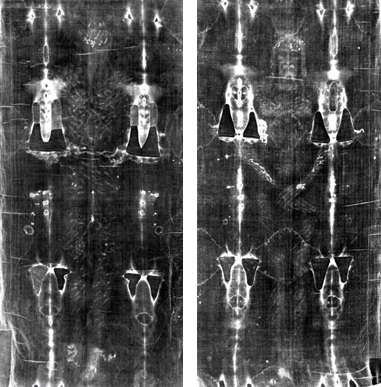
Figures 7 and 8: Dorsal side of the body on the Shroud on the left, frontal side of the body on the right.
©1978 Barrie M. Schwortz Collection, STERA, Inc.
The only really extensive scientific investigation of the Shroud took place in October 1978. The Shroud of Turin Research Project (STRUP) team spent five continuous days performing a series of tests on the Shroud. They were, however, required to do testing that was non-destructive. Many of the scientists on the team had world-class reputations in their respective fields. They represented a variety of theistic views; varied enough that no one view was dominant. Had there been any theistic belief requirements, most of the team members would not have participated.
STRUP’s primary goal was to examine the physical and chemical properties of the image. The group had three specific questions that they wanted to answer: What is the image composed of? What was the process that formed it? What is the composition of the bloodstains?
Their first hypothesis was that the image was, in fact, an artifact—i.e., a painting. Numerous tests were designed to test this hypothesis, including: direct microscopic examination; different forms of spectrometry; fluorescence studies; photographic imaging; electron Microscopy; and samples taken for later microscopic and chemical examination.
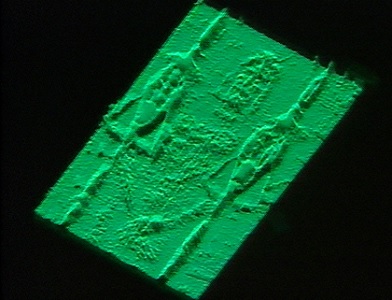
Figure 9: The frontal image of the Shroud viewed on the screen of a VP-8 image Analyzer.
©1978 Barrie M. Schwortz Collection, STERA, Inc.
No paint or pigment of any kind was found on the cloth. The direct microscopic examination of the image itself revealed that the color of the image does not penetrate the cloth in any image area. The image does not go through the flax linen to the other side, but is only on the very top fibers (10-20 microns-–thinner than a human hair). There is NO evidence for cementation between the fibers. There is NO evidence for capillary flow of liquids either. The bloodstains, however, did show this capillary effect as would be expected of a liquid.
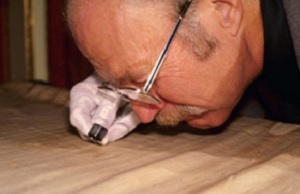
Figure 10: Dr. Ray Rogers inspecting the image with a magnifying glass.
©1978 Barrie M. Schwortz Collection, STERA, Inc.
The density of the image is not due to an increase in the intensity of the individual fibers making up the thread. All the threads have exactly the same intensity of discoloration on them. The image is due to an increase in the number of discolored fibers. This effect shows up in Figure 11. The figure also shows the discoloration to be only in the very top fibrils of the threads. This feat would be virtually impossible for a medieval artist to accomplish.
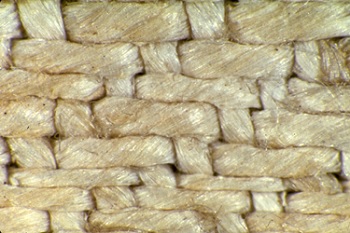
Figure 11: A micrograph of the image in the area of an eye showing the discoloration of the fibrils (magnification of 32x).
©1978 Barrie M. Schwortz Collection, STERA, Inc.
Other tests showed NO traces of dyes, stains, pigments, or painting media that would be expected on a painting. The microscopic and chemical data suggested that the image was the result of some form of cellulose degradation effect.
There were a number of scorches as a result of the fire. But above and beyond that, there were other effects of note: where the scorches crossed the image, the scorches had not changed either the color, or the density of the image; the water used to put out the fire did migrate through the cloth in both the scorched and unscorched image areas; material used in paints would have affected the migration.
This leads to the primary conclusion of the STRUP team that the image is not made up of an applied pigment. Thus, it can be said that “The Shroud is not a painting.”
Studies were also made of the areas showing blood stains. Samples were taken from the cloth to be brought back to the various laboratories in the United States. Several individuals were involved in the studies. The first to look at the samples was Dr. Walter McCrone. Others involved in studies of the Shroud were Ray Rogers, Roger Morris, Dr. Sam Pellicori, Dr. John Heller, and Prof. Alan Adler.
These studies would lead to a rather difficult situation initially. On inspecting the samples, Dr. McCrone claimed that: there were very fine particles of very finely powered iron oxide; there were traces of a dried paint medium—collagen tempera; he identified mercuric sulphide (artist’s vermilion), ultramarine, orpiment and madder. All of these led him to conclude that the Shroud was indeed a mere painting. At a meeting of the STURP team in March 1979, McCrone further said that the body images had been made by red iron oxide earth pigments. He also claimed that the blood was made of iron oxide paint.
Roger Morris performed X-ray fluorescence tests on the Shroud. He found that the presence of iron was spread out uniformly over the Shroud, with the exception of the blood areas, where it was higher than elsewhere. This is to be expected due to iron atoms in blood. There was NO measurable amount of inorganic substances.
A further analysis by Ray Rogers also suggested that there were no organic and biological substances present. Dr. Sam Pellicori, an optical physicist, measured the spectrum of iron oxide on many occasions. He stated that the color from the image was totally wrong for what Dr. McCrone was claiming. McCrone claimed that the X-ray fluorescence studies must then be wrong; his microscopic examinations confirmed that the Shroud had been painted.
In turn, Dr. John Heller and Prof. Alan Adler studied the blood stains. They did a number of chemical tests at the Air Force Academy at another STURP meeting. Using sensitive chemical tests, the two couldn’t find any gelatins in the samples. With further testing on the samples, they satisfied themselves that the stains were indeed most probably human blood. Both Adler and Heller have world-class reputations in blood chemistry. Prof. Adler wrote in his book: “That means that the red stuff on the Shroud is emphatically, and without any reservation, nothing else but B-L-O-O-D!” 6 There were 13 different tests for blood performed; each showed a “positive” for blood.
By the time Dr Heller and Prof Adler were finished, they had performed over 1,000 experiments. They succeeded in eliminating all paints, pigments, dyes, and stains in the blood samples. They had been able, by chemical means, to reproduce the straw-yellow color of the image by a “dehydrative acid-oxidizing agent.” Their theory was that heat might be involved in the image formation. However, no heat source could account for the resolution, or the three-dimensionality of the image, or its color.
So how to account for these disagreements? Several explanations are possible. Capillary flow of liquids would have carried the discoloration deeper into the threads. This effect was not observed. The chemical tests used by Dr. McCrone were prone to false positive results. The iron oxide particles were contaminates from glass plates used in exhibitions of the Shroud. Probably the best reason would be that the Shroud had been copied many times over the centuries; the Shroud was exposed to these copying materials because artists touched their copies to the original for additional blessings during 52 documented occurrences.
There is one more possibility: during the retting (soaking in water) process of producing the fibers for use in the making of the cloth, the iron oxide was deposited by the water used in the process. The most widely practiced method of retting is called “water retting,” that is, submerging bundles of stalks in water. This process is followed by a drying period that eases the removal of the fiberous material.
The conclusions about the amount of iron oxide can be summarized by saying that there was insufficient iron oxide on the cloth to account for the image.
STURP team members continued their research after their access to the Shroud, and published many of their results in scientific journals and proceedings. In 1981, in its final report, STURP wrote:
We can conclude for now that the Shroud image is that of a real human form of a scourged, crucified man. It is not the product of an artist. The blood stains are composed of hemoglobin, and also give a positive test for serum albumin. The image is an ongoing mystery, and until further chemical studies are made, perhaps by this group of scientists, or perhaps by some scientists in the future, the problem remains unsolved.7
In their summary, the STURP members also concluded that some explanations for the image formation that were possible from the physical point of view, were not allowed by the chemistry. And, vice versa, chemical explanations that were possible were not allowed by the physics. Whatever explanation that is scientifically sound has to be so from a physical, chemical, biological, and forensic viewpoint. Skeptics must match all these different conditions to prove the Shroud to be a fake. So far, the Shroud has survived all such attempts.
There were some pollen analyses done to samples taken from the Shroud. Dr Max Frei, a pollen expert, sampled several areas of the Shroud. Frei had identified pollen spores of 58 different plants, many that originate only in and around Jerusalem, and areas of the Middle East, that include the ancient cities of Constantinople and Edessa. While some skeptics tried to explain away his work, all were shown to be wrong. Dr Frei found no glue binding the pollen to the cloth, nor any tempura on the pollen grains. The pollen spores provide us with a geographic history of the Shroud. They tell us where, but not when (except perhaps for the season of the year) the Shroud was kept.
The Carbon 14 Test
It is now time to take up the elephant in the room—the Carbon 14 dating of 1988. The C14 dating of the Shroud was initially taken as the definitive answer to the age of the Shroud. It has, however, come under increasing criticism. Amongst all the data collected by the scientists who studied the Shroud, this was the one piece that did not fit. It has been discounted as a valid result for the age of the Shroud.
When plants fix atmospheric carbon dioxide (CO2) into organic material during photosynthesis, they incorporate some C14 that approximately matches the level of this isotope in the atmosphere. After plants die, or they are consumed by other organisms, the C14 fraction of this organic material declines at a fixed exponential rate due to the radioactive decay of C14. Comparison of the remaining C14 fraction of a sample to what is expected from atmospheric C14, allows the age of the sample to be estimated.
At a radiocarbon conference held in Trondheim, Norway, in June 1985, a rather stringent protocol was agreed to regarding the Shroud C14 testing. There would be six different laboratories doing the testing. Of the six labs involved, four would use one method of testing, and the others a different method; there are two such methods. Three samples would be taken from different parts of the Shroud.
These procedures would help eliminate biases involved in the testing methods, and ensure the reliability of the tests. None of the labs were to know which sample of the several samples they were sent, was the Shroud sample. Control samples of known age, as well as the Shroud sample, were sent to each lab. This was to be a blind test.
In the end, the whole protocol was thrown out. Only three different labs did the actual test, and they all used the same method. Only a single sample site of the Shroud was chosen. The sample was divided in half; one half kept in reserve while the other was split into thirds, and sent to the labs for analysis. The labs had no problem identifying the Shroud sample from the control samples they were sent because it had a distinctive weave that was unlike the other samples.
There are, however, concerns about this method of dating: the variation of C14 production in the atmosphere and contamination. Contamination can be introduced in a number of ways, based on many different environments, and varying handling conditions. It is well-known fact, all-together, that too often unexplained and discordant values (as many as 1 in 5), have been obtained, and archaeologists will dismiss them when there is clear evidence of a known age from other sources. A chemical characterization of the sample is also part of the complete checking of any sample before it is destroyed in the test.
A single sample is never sufficient for experimental certainty. This is especially true when dealing with material that is far from uniform in its present state. Unknown handling, repairs, and storage under unknown conditions, are all factors that can affect the results.
Besides the errors already mentioned, standard cleaning procedures were used for the samples. It was unknown just how well they worked. A chemical characterization of the samples was not done by any of the labs; had they done so, and compared it to the work done by STRUP, it would have been readily apparent that something was amiss.
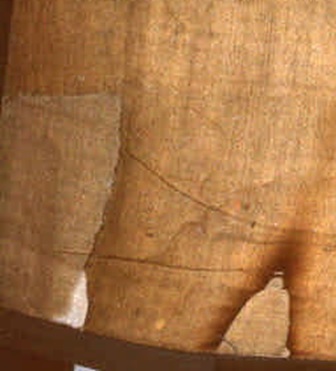
Figure 12: UV fluorescence photograph of the C14 sample area.
©1978 Barrie M. Schwortz Collection, STERA, Inc.
In Figure 12, the area where the radiocarbon sample was taken is relatively dark, a fact that is not the result of dirt, image color, or scorching. The cloth is much less fluorescent in that area. It brightens into more typical fluorescence to the right. This then proves that the radiocarbon area has a different chemical composition than the rest of the cloth. Obviously, this was not considered before the sample was cut.
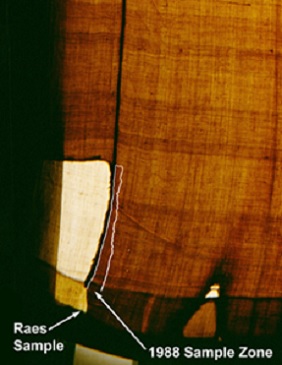
Figure 13: A transmitted light photograph of the Shroud of Turin ventral image showing a close up of the corner where the 1988 C14 sample was taken.
Labels also indicate the 1973 Raes sample area. In this version the C14 sample area is also outlined (approximate only).
©1978 Barrie M. Schwortz Collection, STERA, Inc.
In Figure 13, the area of the C14 samples is illustrated. The Raes sample shown here had been taken by Gilbert Raes (of the Ghent Institute of Textile Technology) to do a study of the cloth material itself. It was not part of the C14 testing.
The choice for the area to take samples for the dating was unfortunate in several respects: It was taken from only one location for all three labs. Therefore, any errors would be repeated by all three. The area from which the single sample was taken was also the one area that was handled by so many people during the various displays of the Shroud over the centuries.
Results were announced before peer review and publication. Peer review is an important part of any scientific presentation in a journal. It is used as a way of checking the methodology of the authors, as well as checking the consistency of their results.
Since 2005, at least four articles have been published in scholarly sources stating that the samples used for the dating test may not have been representative of the whole Shroud. According to former Nature editor, Philip Ball, “…it’s fair to say that, despite the seemingly definitive tests in 1988, the status of the Shroud of Turin is murkier than ever. Not least, the nature of the image, and how it was fixed on the cloth, remain deeply puzzling.”8 The shroud continues to remain one of the most studied and controversial artifacts in human history.
Sue Benford and Joseph Marino examined the documenting photographs of the C14 samples, and other close-up photographs of the Shroud. They found clear indications of a discrete repair to the Shroud. The repair seems to have been subjected to what modern tailors call “invisible reweaving.” This results in an intermingling of newer and older threads. The newer thread is carefully dyed to match the older material so that it becomes almost invisible to the naked eye. Enough newer threads were identified so that Ron Hatfield, of Beta Analytic, one of the world’s largest C14 dating firms, could estimate that had the cloth of the Shroud been from the 1st century, and the new cloth added from the 16th century, the results would have been what the C14 tests revealed.
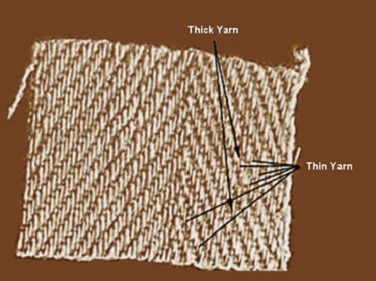
Figure 14. Front-side of the Zurich C-14 sub-sample used to date the Shroud in 1988. Weave pattern inconsistencies noted in blinded review of Zurich C-14 sample by Albany International Research Company.
This, of course, raised the question of why a patch was even needed. There is a possible explanation. The Duchess Margaret (then owner of the Shroud) died in early 1531. In her will, she stated that she wanted to leave a piece of the Shroud to her church of Brou at Bourg-en-Bresse. Her will was appropriately executed. There is, however, no contemporary record of a piece having been removed as she had asked. There are indications, though, that it may have been done. A Shroud replica, commissioned 40 years later for Don Juan of Austria by Pope Pius V, shows a corner of the Shroud cut away. The section removed was about 5.5 inches x 3.5 inches. The section was then replaced with an invisible patch.
Ray Rogers, retired Fellow with the Los Alamos Scientific Laboratory, and lead chemist with STURP, had nothing nice to say about this theory of a rewoven section of the Shroud. He decided to prove Banford and Marino wrong. This is not, however, how it worked out.
In an article published Jan 20, 2005 in ThermoChimica Acta,9—peer reviewed scientific journal of very high repute—Dr. Rogers proved conclusively that the sample cut from the Shroud of Turin in 1988 was taken from an area of the cloth that was re-woven during the Middle Ages. Had the original protocol for the Carbon 14 dating been followed, it would have become apparent that there was something different about this area of the cloth.
Al Adler found a number of materials in the radiocarbon sample that were peculiar to the sample: large amounts of aluminum; it was coated with a plant gum, aluminum oxide mordant, and Madderroot dye. The radiocarbon sampling area had been dyed to look like the rest of the cloth. The sample chosen for dating was just plain wrong for determining the true age of the Shroud. Ultraviolet and x-ray photographs taken in 1978 showed that there were chemical differences. These chemical differences invalidate the C14 testing of the Shroud itself because a representative sample of the Shroud was not tested.
Efforts to Reproduce the Shroud
There have been many efforts to reproduce the image on the Shroud. Many of the efforts to disprove the authenticity of the Shroud involve showing how it could have been made by a medieval forger, using technology supposed to be available at the time. One theory even ascribes the Shroud to Leonardo da Vinci, despite the fact that the history of the Shroud, as we know it now, can be traced back to 100 years before da Vinci was born.
Some efforts have reproduced an image similar to the Shroud. A few even have had some semblance of a 3-D image. But not one has reproduced the Shroud image in its entirety; all fail to provide the same quality image produced by the VP-8 Image Analyzer of the Shroud. Different methods tried include: Camera Obscura, hot statues of various materials, rubbings—both hot and cold, finger painting, and attempts at painting with a number of different materials.
Other theories consisted of: The Vaporgraph Theory of Paul Vignon, and a Scorch Theory proposed by Geoffrey Ashe. Another theory is the use of an etched or scribed flat plate.
The scorch theories have all been found wanting for various reasons. One feature of a scorch impression is that it will fluoresce under ultra-violet light. The image does NOT do so, however. This proves that the image is not accomplished by scorching.
Unfortunately, vapors do not rise directly upward. They diffuse randomly in all directions. Vapors and liquids penetrate the cloth. Materials that will color the surface, will also diffuse into, and color, the inside of the cloth. This would produce an extremely distorted image, if one was formed at all. This eliminates any vapor-based theory of image formation.
The camera obscura method is an early form of photography. It has been used to actually form an image very nearly like the image on the Shroud. It does have a nearly photographic negative quality. Producing an image in this fashion has several problems: it does not match the Shroud image photographically or chemically. Another problem is how to locate the blood stains in the appropriate sites because they were placed on the Shroud BEFORE the image formation took place.
The materials needed by a medieval artist to create an image by this method were available: urine (ammonium hydroxide); light sensitive silver salts (Silver is the only element with the necessary properties to make a light sensitive image); a room sealed from light except from a window with a quartz lens. However, there is a major problem with this method being the one used by the presumed artist: there were no traces of silver on the Shroud. Thus, the image is NOT a photograph.
The efforts to reproduce the Shroud, tried by the skeptics in an effort to prove it to be a medieval forgery, have been less than successful. They must match the physical, chemical, and forensic qualities to be considered a success. But such efforts persist even though the appropriate matches are missing.
But not all efforts to reproduce the Shroud were done to prove it to be a fake. Several scientists involved with the STRUP team did some testing in an effort to understand the mechanism that formed the image in the first place. John Jackson, Eric Jumper, and William Ercoline wrote a paper comparing the image intensity with the 3-D structure of a human body shape. In it, they used several artists who were to try to reproduce the image by several different painting techniques. The results were published in an edition of Applied Optics.10 The artwork they had various artists produce was put through the VP-8 analyzer with results that were not even close to the Shroud image from the same device.
A number of theories of image formation involve radiation of some form. Radiation comes in two forms: electromagnetic (light or radio waves for instance), and nuclear (emission of various sub-atomic particles). Electromagnetic radiation is a type that would be difficult to claim in the image formation process because it is a type of radiation that radiates in all directions equally; it would discolor the cloth equally, all over its surface. This would not allow an image to form. Nuclear radiation in the form of a bombardment by heavy, but electrically-neutral particles was also considered. Such particles would pass through each thread, damaging the interior of each thread. No such damage was observed in any of the threads inspected in any of the studies on these samples. Thus, radiation as a mechanism of image formation was ruled out.
Initially, the image was thought to have been formed by some means of dehydration of the fibrils in the cloth. Something unexpected happened. Both Ray Rogers and Alan Adler, had carefully studied the image fibers in the tape samples taken from the Shroud by Rogers in 1978. They observed that when Shroud image fibers embedded in the tape gum were removed, the image color stripped off the fiber, and remained behind in the tape gum itself. The fiber was left clean and intact, with no visible effect on the cell wall.
Ray Rogers did a chemical analysis, and found something called saponeria, or soap weed. This is a naturally-occurring detergent used in manufacturing ancient linen. The cloth was then left to dry in the sun. This process leaves a residue on the top surface of the cloth by evaporation. Rogers determined that if a Maillard Reaction (this is the same process that leaves your dinner rolls brown on top after baking) took place only where ammonia escapes from a decaying body, it could react with the soap weed, leaving the image behind. So far, this seems to be the best explanation for the image formation. But it is unknown if, in fact, this is what happened.
A logical hypothesis for image formation must accept the laws of physics and chemistry, and explain all of the STURP observations.11 Despite the efforts to disprove the authenticity of the Shroud, there is a host of information that tends to support its authenticity. This information comes from physics, chemistry, and forensic analyses. To reproduce the Shroud image, one must match all of this information.
A conservation effort on the Shroud was undertaken in 2002. The effort was done without any fanfare or input from outside sources because a fire, thought to be the work of an arsonist, in the Chapel containing the Shroud was set in April 1997. The effort was to conserve the Shroud, and slow or prevent any further damage to the cloth. Several things were done: a new backing cloth was attached; the burn-hole patches were removed and replaced; the burn holes were trimmed to remove the burnt portions; any material removed from the Shroud was stored in glass vials for future study.
The restoration of the Shroud was done in secrecy to protect it from any further attempts at damaging or destroying it. The scientific aspects are of secondary importance. Any further scientific work would only deal with the authenticity of the Shroud, and the image formation process. These were not the primary goals or concerns of the Church.
Further analysis of both sides of the Shroud was also accomplished. Both sides were digitally scanned with the results stored on a computer. The Shroud was then stored in a new container with an atmosphere of argon, and a small amount of oxygen. It is also unfortunate that the image itself may have been slightly degraded in the restoration process. No attention was given to preserving any more chemical data that might have been retrieved after the preservation. Nor were there were any protocols to describe how to label the material that was removed from the Shroud.
The scientific community was upset because the Shroud is an object of immense scientific and historical significance. It is also of immense archaeological interest. If it is genuine, it records an historical event that is the center of a major world religion.
A strong case has been made for authenticity but this is still not proof. The testing done by STRUP in 1978 was done with technology that was top-of-the-line in 1978. But technology marches on. Thus, there may be some new technology that will allow further analysis to be done with more definitive results and no damage to the Shroud.
Summary
We can summarize what we know and don’t know about the Shroud. We can say several things about what it is not: NOT bodily secretions; NOT a burn mark or scorch; NOT a painting, dye, etching or rubbing; NOT a medieval photograph; NOT made by an artist.
The Shroud image has a number of characteristics (some of them unique to the Shroud):
There is a cloth-to-body distance relationship; the body is in rigor mortis, image created within 48 hours of death; there are light/dark characteristics similar to a negative photograph; human blood went on the Shroud first (blood removed, no image); the image contains a brightness map revealed with the VP-8 Image Analyzer; there are serum Albumin Halos around scourge marks (cannot be observed by the naked eye, usually by fluorescence), a feature unknown in medieval times.
The blood on the Shroud has been tested by more than one researcher. It has been typed as AB, but the Rh factor cannot be determined. It is also of interest that the blood is still red. Old blood should be black or brown. But when a body undergoes a traumatic experience for an extended period of time (24+ hours) the liver releases a substance called “bilirubin” which keeps the blood red forever.
Recovering DNA from the blood has also been a topic for discussion. Unfortunately, this is not possible. The blood has been too degraded for this kind of analysis, so any attempt would be fragmentary at best. It is also true that many people have handled the Shroud over the years. As a result, they left their DNA on the Shroud as did the STRUP scientists during their testing. So even if we could get a reliable DNA sample, we would have no way of knowing to whom it really belonged.
What we can say further is that its history and valid scientific evidence make a strong case that the Shroud is indeed a genuine burial cloth of a Roman-style crucifixion victim. “Valid” is emphasized here because much of what is written in books, and on websites, is of a polemical nature—by believers and skeptics alike—more critical and controversial in nature rather than an honest discussion of what is known or not known. On the other hand, the work done by the STURP team was submitted to peer-reviewed scientific journals for publication.12 We can be sure that what was in each paper is legitimate science—even if we don’t necessarily agree with the conclusions.
It is certainly much older than the now discredited radiocarbon date of ca. 1260-ca. 1390. This is supported by chemical evidence. Science can and does rule out fakery but it cannot rule out a miracle. If the Shroud is authentic, it is undoubtedly the oldest historical document about the death of Jesus; it is evidence that lends credence to the Passion story related in the Gospels. Is this evidence of a resurrection? Indirectly, perhaps. If it is a burial cloth, then it is obvious that the body it wrapped, was separated from it soon after burial, before decomposition products left their marks on the cloth. Science is not capable of answering the question of a resurrection. It is not something that can be put to a test in a laboratory.
The physical sciences, by themselves, cannot establish the identity of the person wrapped in the Shroud. They can, and should, analyze any and all means suggested for the image and stains we have seen on the cloth. Science can tell us more about what it is not. To identify the individual, we need other evidence from a different source or sources. Determining the Shroud’s authenticity depends on science, not faith. Science says the man of the Shroud died a violent death by crucifixion. The Gospels tell us of someone, namely Jesus, who was beaten, crowned with thorns, and crucified—all the wounds corresponding to those visible on the Shroud.13 Most of what we read there could have been any crucifixion victim, but with one exception—the crown of thorns—historically, we have only one description of a crucifixion where the victim was given a crown of thorns, an occurrence recalled in those same Gospel stories.14
After a century of scientific study, we still cannot answer the two most important questions about the Shroud: “How old is it?” and “How was the image formed”? Any more scientific study can only contribute to the body of evidence for the authenticity of a 1st century artifact.
Even if the Turin Shroud were of no interest for religious, historical, or archaeological reasons, its very existence as an object with a peculiar image would stir our scientific curiosity. What explanation can be given to account for the formation of an image that is the only one of its kind known so far in the history of the world of art and technology, and that we cannot reproduce with all the knowledge available at the end of the 20th century?… Only the discovery of other images comparable to it would provide a basis for establishing its lack of special interest.15
Considering other cloths with images on them, Robert Wilcox, a journalist writing about the Shroud,16 went to several different museums trying to find such cloths with images on them. He found none, even though he found cloths of about the same age as the presumed age of the Shroud.
When it comes right down to it, several things may be said: The believer needs no more proof. The Shroud is an object that makes us think about its significance. The skeptics must prove that the Shroud of Turin is a forgery or an artifact; they need to prove that it is anything but the burial cloth of Christ. We have enough evidence to accept in a court of law that it is, indeed, the burial cloth of Jesus Christ.
In general, believing is a matter of faith, defined here as what one believes from honest enquiry. It takes a leap of faith in the data available (both scientific and historical) to decide what to believe about the “Man of the Shroud.” There is no scientific test for “Christ-ness.”
The Catholic Church has made no pronouncements about the authenticity of the Shroud. It has allowed it as a reminder of the act that justifies all of Christianity. Not everyone needs such a physical object to justify their faith; we then have a unique artifact with a curious image on it. But for those who find such an artifact useful, we have here one that may, indeed, help reinforce our faith.
It can then be said that the meaning of the Shroud is to be found in the hearts and minds of those who look upon it. What then do you, the reader, make of it; and what does it mean to you?
- huffingtonpost.com/2015/04/20/shroud-of-turin-display_n_7102964.html ↩
- In his book A Doctor at Cavalry ↩
- In his book The Crucifixion of Jesus: A Forensic Inquiry, M Evans and Company, Inc, New York, 2005. ↩
- See this presentation for more information on the VP-8: shroudnm.com/docs/SEAM-VP8-Presentation.pdf ↩
- From an interview with Barrie Schwortz that can be found on Shroud.com. ↩
- Heller, J.H., 1983, “Report on the Shroud of Turin,” Houghton Mifflin Co: Boston MA, pp.215-216 ↩
- shroud.com/78conclu.htm ↩
- Taken from Shroud.com ↩
- Rogers, Ray, “Studies on the radiocarbon sample from the Shroud of Turin,” Thermochimica Acta, Volume 425, Issues 1-2, Pages 189-194. ↩
- Applied Optics, Volume 24, Number 14, pp. 2244-2269. ↩
- STRUP conclusion can be found at Shroud.com: shroud.com/78conclu.htm ↩
- A list of papers can be found at Shroud.com: shroud.com/78papers.htm ↩
- See Ian Wilson, The Shroud of Turin: The Burial Cloth of Jesus Christ?, Rev Ed pp. 51-52 for a list of the relevant Gospel passages. ↩
- See note 13. ↩
- Comments from The Shroud of Turin from the Viewpoint of the Physical Sciences by Fr. Manny Carreira, S.J. published on the shroud.com website. ↩
- Wilcox, Robert K., The Truth About The Shroud of Turin: Solving The Mystery, Regency Publishing, Washington, DC, 2010. ↩
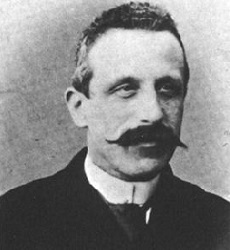
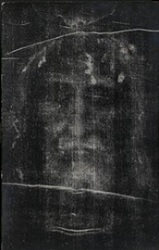
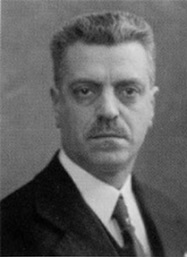
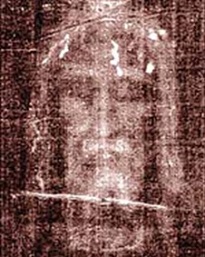
Are you aware of the Face Cloth at Mannopello Italy and how its image almost exactly matches that of the Shroud of Turin? There are at least two books that discuss this.
I know of the Face Cloth but have not read either of the books about it.
One of the books is ” The Face of God ” by Paul Badde , published by Ignatius Press. I cannot find the other book I have read on the subject. If one has an interest in the Shroud it is imperative you read Paul Badde’s book. ” When the face of the Shroud of Turin is laid over the face of the Veil of Manopello, the two images form a perfect match. It is a perfect match.”
This is, apparently, a controversial topic. You can go to the website Shroud.com. In the search engine type in “Manoppello”. You will get about 40 different locations that discuss this topic. You could also try other spellings of Mannopello and see what you get. If you only get a few (10-12) try a different spelling.
I too was one of those fortunate visitors to view the Shroud in June 2015. I found Mr. Hain’s article to be both comprehensive and fascinating. In reading about the various studies done on the Shroud, one hopes (at least I did) that its authenticity would be scientifically proven beyond any reasonable doubt. But does that not make us in some way equivalent to the “doubting Thomas”. Do we really need that reinforcement to our faith? Rather, I would like to agree with Mr. Hain’s summary statement that the meaning of the Shroud may best be found in the hearts and minds of those who look upon it. As Jesus tells us in John’s Gospel: “…Blessed are those who have not seen and have believed.”
Not everyone needs such physical objects to reinforce their faith. But for those who find it useful to confirm what they already believe, then it is useful. I suspect, and only that, that this piece of cloth was left behind for those who need some help with some sort of physical object to contemplate. Perhaps it has been left behind to work on those who have little or no faith at all–it needs some sort of explanation.
It is God and it isn’t. We have to believe that this happened to Christ whether this shroud was his or not. That is the faith we all need to have. The article is very good and interesting.
Mr. Hain; Thank you for a great article! I fall under your sentence; “But for those who find it useful to confirm what they already believe…”, and my reading of the Gospels show me that above much else, people’s faith in God was of primary importance to Jesus. In many of His healings, He says “Your faith has saved you.” Even His own followers faltered in their faith in His Divinity, never mind us here 20 centuries later! I agree with your “suspicions”, that He allowed it to remain in order to help bolster weak faith in God’s goodness! Fascinating science, to be sure, and I appreciate your contributions! Peace!
I must agree that a little empirical evidence helps. With my engineering training and much science reading, some empirical evidence helps to reinforce what I believe.